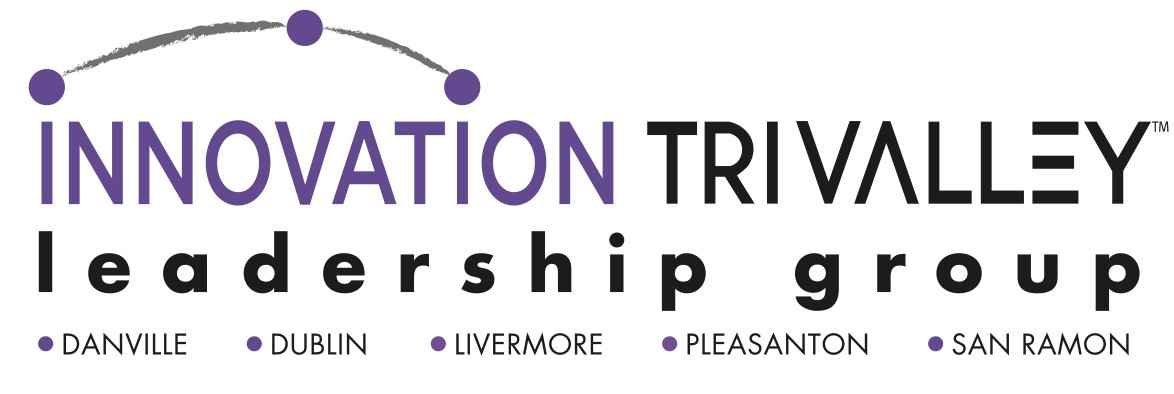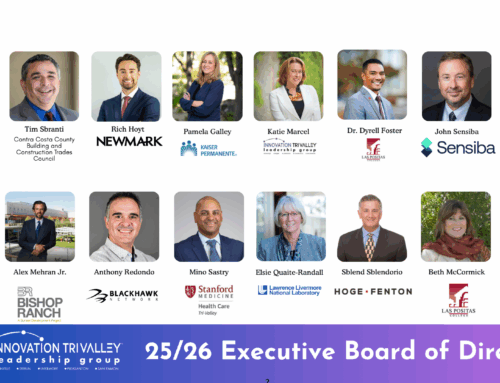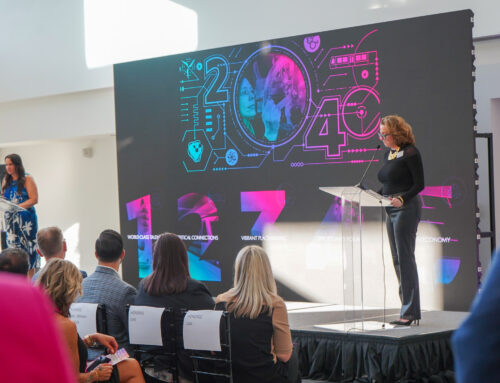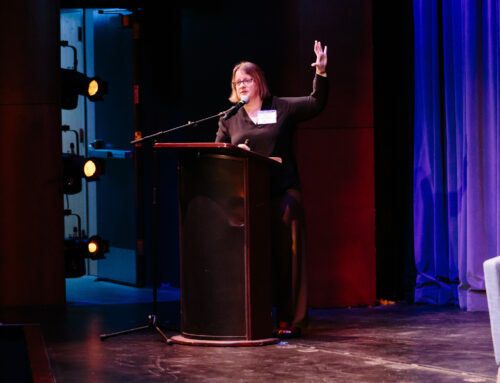One of the business sectors really booming here is life sciences.
Pleasanton has long been home to major campuses for Roche Molecular (Hacienda Business Park) and Thermo Fisher Scientific (Sunol Boulevard) as well as Abbot Laboratories (Stoneridge Drive, formerly Thoratec).
What’s changed in the last decade in Pleasanton is life science startups have flourished here.
Lauren Moone, executive vice president of Mirador Capital in Pleasanton, summarized the sector here at the inaugural Tri-Valley Life Sciences Summit last November. She said there are more than 120 life science companies in the Tri-Valley, and 90% of those are making devices. Through 10 months in 2018, about $300 million had been invested locally by venture capitalists with 60% of that going to device manufacturing firms.
These range from the CoolSculpting devices seen on TV with pro golfer Ian Poulter (Pleasanton-based Zeltiq developed the technology and was acquired by international firm Allergan in 2017) to home male fertility tests by Trak (being marketed by Sandstone Diagnostic of Pleasanton) to infant diagnostic equipment made by Natus, a $500 million company, to revolutionary biologic research equipment manufactured by 10X Genomics and Unchained Labs.
Why? Business leaders point to three key factors:
1. Location, location, location. When developer Joe Callahan and the Prudential Insurance Company put together Hacienda Business Park in the late 1970s, there was a 30-minute commute shed to the intersection of interstates 680 and 580, with workers coming from around the compass. Add in the BART line and the ACE Trains and the competitive advantage is even stronger. The proximity to the Bay Area provides access to the best technical and scientific talent, while skilled manufacturing workers often live in San Joaquin County.
2. The presence and eagerness of Sandia and Lawrence Livermore national labs to license their technology and/or partner with the private sector. Former employees there have left to form their own successful companies, and Sandia even offers a tryout where employees can move into the private sector and then return to the lab within two years with no loss in seniority. The labs’ decision to develop the Livermore Valley Open Campus in 2009, including the decades-old Combustion Research Facility at Sandia, has invited companies to partner.
3. Senior executives have lived in Pleasanton and other Tri-Valley communities for years and commuted over the Sunol Grade or over a bridge to San Francisco or the Peninsula. They’ve found the business climate in Pleasanton ideal to build their companies.
For instance, Tim Harkness, founder and CEO of Unchained Labs, has lived in Pleasanton since 2005. During that time, he built and sold two life science companies that were based in the South Bay. He described getting to the office at 5 a.m. to try and leave before the Sunol Grade became a parking lot. He’s an evangelist for Pleasanton for life science companies.
“I love Pleasanton. It’s a perfect place to build a business — great schools and a relatively lower cost of living. What I have found is it is a competitive advantage for hiring. I didn’t know that was going to be the case when I set up the business here. It’s the best decision I ever made for personal life and the community,” Harkness said.
His commute now is 13 minutes by car to the headquarters in Koll Center or 25 minutes on his bike.
When Serge Saxonov and Ben Hindson decided to found 10X Genomics, Saxonov said they had an open mind about where to headquarter the company. They checked out South San Francisco (the original life sciences hub in the Bay Area), the Peninsula, the South Bay, the I-880 corridor (Emeryville is another hub) and even Marin County.
Their decision was Pleasanton was the best location.
“Pleasanton had a number of things. With the commute pattern, we could get people from all across the Bay Area,” he said. “In the early days, the cost and availability of space (both office and importantly, labs). It’s been great for people moving from outside the area who can actually afford to buy a house, and the schools are great.”
He emphasizes that what defines 10X is the talent of its employees. The founders all hold PhDs and that’s the educational level of many of their employees. It’s also multi-disciplinary with chemists, software engineers, hardware engineers and biologists.
Unchained Labs has a similar research and development team. Both manufacture their products in Pleasanton. They each make tools to greatly improve the research capabilities of life science companies.
10X is focused on the genome, while Unchained’s tools are for research into proteins. Both companies are flourishing. Last fall, 10X leased 150,000 square feet on Stoneridge Mall Road, nearly tripling the 40,000 square feet it has in Koll Business Center. It plans to hire 200 people across the company, growing by 50% this year and formally became the valley’s first home-grown life science unicorn when its value exceeded $1 billion.
Unchained, which has sold more than 2,300 pieces of its equipment, started in February 2015, and is now financially self-sufficient. The goal is to build a $100 million biologics pure play company. Most of Harkness’ executive team have worked together at other life science companies.
Saxonov noted that only about 5% of biology is understood so their tools can propel major innovations. One of their success metrics is how many research papers customers publish after using their tools.
Hindson and Saxonov worked together at QuantaLife, which licensed a technology from Lawrence Livermore in 2008. Bill Colston, who spent 20 years at Lawrence Livermore, served as the CEO of the firm. Ted Tarasow, another former lab manager, also joined the firm.
It was acquired by East Bay life science pioneering firm, Bio-Rad Laboratories for $162 million in 2011. QuantaLife developed a proprietary nucleic acid testing method. The Pleasanton company is the core of BioRad’s Digital Biology program, which is headquartered here in two buildings that were purchased last November, totaling 101,000 square feet.
The QuantaLife sale spawned three other companies. Saxonov and Hindson founded 10X Genomics, while CEO Colston founded HealthTell in Pleasanton where Tarasow is vice president of product development and Klint Rose co-founded Purigen Biosystems in Pleasanton and serves its chief science officer. Colston serves on the board.
Pleasanton-based Sandstone Diagnostic’s technology roots are from Sandia where Greg Sommer and Ulrich Schaff helped develop a medical diagnostic device designed for use on the battlefield. The company now is marketing its at-home fertility test kit for men (Trak).
Meanwhile, Sandia researchers have continued to improve the device. The latest generation, portable and rugged, can diagnose up to 64 assays on a single disk within 15 minutes using a drop of blood. It likely will have wide application both in the United States and other western countries, as well as in developing nations — for instance when there’s another Ebola outbreak.
In addition to BioRad’s commitment to Pleasanton, startup Gritstone Oncology, headquartered in Emeryville, opened a 43,000-square-foot manufacturing facility here. The biomanufacturing facility, with multiple clean rooms, will be the site of Gritstone’s personalized cancer immunotherapy manufacturing.
There’s already a critical mass of life science firms here.
What Pamela Ott, the city of Pleasanton’s director of economic development, and Yolanda Fintschenko, co-founder of the East Bay Bio Network, are doing is helping them network together to enhance the ecosystem. Fintschenko, who worked 10 years at Sandia and then moved to Thermo Fisher, said, “This a healthy environment for life sciences with so much local talent.”
“We’re focused on introducing life scientists to others in the Tri-Valley,” she added. “We start our events with a mixer, then have one entrepreneur interview another and then finish with a mixer. We create the environment to get the right people in the room.”
One of those mixers resulted in two women starting a company that now is working out of i-Gate in Livermore. I-Gate, formed by the national labs and the city of Livermore seven years ago, operates an incubator and co-working site, Switch, on 2nd Street in Livermore. It’s another key part of the infrastructure.
“There’s been a growing desire from the national labs to partner externally and be sure that local startup entrepreneurs and their own people know they are open for business,” said i-Gate executive director Brandon Cardwell. “The labs have made a concerted effort to engage more with the local economy.”
He added, “When people move here, they have the opportunity for a better quality of life and can volunteer as coaches and be involved in the arts.”
National labs embrace private industry partners
Lawrence Livermore and Sandia national labs have been the technology hub of the Livermore Valley for more 50 years. The mission initially was focused on the nation’s nuclear weapons that aim to serve as a deterrent to potential enemies to this day.
In the 1990s, the national security mission broadened in anticipation of potential chemical, biological, radiological and nuclear threats. For instance, the technology was used in the government response to the anthrax attacks after 9/11. And 9/11 accelerated the research in these areas.
Since 1980, Sandia researchers have partnered with industry on the Combustion Research Facility. That pioneering effort led to the development of the Livermore Valley Open Campus, a joint venture between the two labs on the east side of both facilities. Collaboration with industry and academic researchers has soared with both labs dedicating employees to working with outsiders.
Lawrence Livermore is opening its first new building, the Advanced Manufacturing Laboratory. It has a 5,000-square-foot “wet lab” and a 5,000-square-foot “dry lab” that includes a special enclosure to process reactive materials. It’s designed to work with industrial partners who can “spin out” lab-developed technology, while the lab can “spin in” cutting-edge industry technology. A key feature is a viewing area between the two labs to facilitate visits.
Rich Rankin, director of the innovation and partnerships office at Lawrence Livermore, emphasized the importance of the two-way door and encouraged lab employee to “embrace it.” The goal is for win-win solutions. He readily acknowledges that lab researchers can learn from private industry.
Lawrence’s Open Campus also includes the High Performance Computing Innovation Center that is housed in two modular buildings. Since 2011, it has hosted nearly 68,000 visits, nearly 7,000 events and researchers have partnered with companies such as IBM, Intel, Cisco and GE.
Across East Avenue at Sandia, the Combustion Research Facility has a nearly 40-year history of partnering with industry. Cummins produced the first diesel engine designed entirely by computer simulation using software developed at the Sandia facility. It reduced development time and cost by 10% and now is powering more than 200,000 Ram trucks. Auto industry leaders attribute the greatly improved fuel efficiency in their fleets to research done at Livermore.
There’s a lab devoted to algae research that could result in inexpensive biofuels as well as applications for biodefense. Another building houses the researchers who developed the next generation SpinDX, “a lab on a disk.” This was the technology licensed by Sandstone Diagnostics, which was founded by former Sandia researchers Greg Sommer and Ulrich Schaff.
One of the interesting community outreaches Sandia has established is a lunch-hour farmers market that is open to anyone.
Here’s a snapshot of some local companies with people and/or technology from Lawrence Livermore:
* POC Medical System licensed lab technology for the diagnosis of diseases such as cancer, cardiac, neurological and infectious diseases. It is in beta testing for a blood-based test on a portable platform for breast cancer. This will allow cancer screening in rural regions across the globe where screening methods are not available to women. It provides results in 15 minutes from a drop of blood. It’s based in Livermore.
* SafeTraces, Inc., a Pleasanton-based startup, licensed lab technology that has a broad range of applications from securing the food supply chain to tracing the outbreak of food-borne illness. It utilizes DNA barcodes for labeling food ingredients or products. The odorless, colorless and tasteless barcodes are applied directly to food or materials. Scanning the barcode with a reader that uses polymerase chain reaction, it takes only 15 minutes to reveal counterfeit materials or trace a food’s source.
* SHAL Technologies, a Livermore startup, licenses lab technology and developed the first of a new class of small molecule drugs called Selective High Affinity Ligands. The drugs target and kill only cancer cells. Tests with mice infected with human lymphoma showed remarkable efficacy. It is raising funding and applying to Food and Drug Administration for clinical trials.
by Tim Hunt / Pleasanton Weekly







